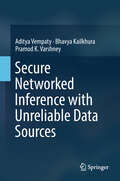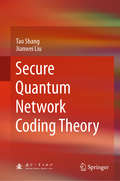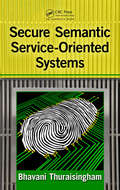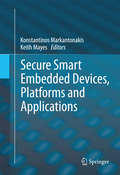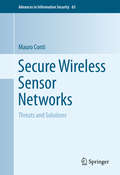- Table View
- List View
Secure Multi-Party Non-Repudiation Protocols and Applications (Advances in Information Security #43)
by José A. Onieva Jianying ZhouThe volume provides state-of-the-art in non-repudiation protocols and gives insight of its applicability to e-commerce applications. This professional book organizes the existing scant literature regarding non-repudiation protocols with multiple entities participation. It provides the reader with sufficient grounds to understand the non-repudiation property and its applicability to real applications. This book is essential for professional audiences with in-depth knowledge of information security and a basic knowledge of applied cryptography. The book is also suitable as an advanced-level text or reference book for students in computer science.
Secure Networked Inference with Unreliable Data Sources
by Aditya Vempaty Bhavya Kailkhura Pramod K. VarshneyThe book presents theory and algorithms for secure networked inference in the presence of Byzantines. It derives fundamental limits of networked inference in the presence of Byzantine data and designs robust strategies to ensure reliable performance for several practical network architectures. In particular, it addresses inference (or learning) processes such as detection, estimation or classification, and parallel, hierarchical, and fully decentralized (peer-to-peer) system architectures. Furthermore, it discusses a number of new directions and heuristics to tackle the problem of design complexity in these practical network architectures for inference.
Secure Networking - CQRE: International Exhibition and Congress Düsseldorf, Germany, November 30 - December 2, 1999, Proceedings (Lecture Notes in Computer Science #1740)
by Rainer BaumgartThe CQRE [Secure] conference provides a new international forum giving a close-up view on information security in the context of rapidly evolving economic processes. The unprecedented reliance on computer technology has transformed the previous technical side-issue "information security" to a management problem requiring decisions of strategic importance. Thus one of the main goals of the conference is to provide a platform for both technical specialists as well as decision makers from government, industry, commercial, and academic communities. The target of CQRE is to promote and stimulate dialogue between managers and experts, which seems to be necessary for providing secure information systems in the next millennium. Therefore CQRE consists of two parts: Part I mainly focuses on strategic issues of information security, while the focus of Part II is more technical in nature. This volume of the conference proceedings consists of the reviewed and invited contributions of the second part. The program committee considered 46 papers and selected only 15 for full presentation. For the participants’ convenience we have also included the notes of the invited lectures and short workshop talks in this volume.
Secure Quantum Network Coding Theory
by Tao Shang Jianwei LiuThis is the first book on secure quantum network coding, which integrates quantum cryptography into quantum communication. It summarizes the main research findings on quantum network coding, while also systematically introducing readers to secure quantum network coding schemes. With regard to coding methods, coding models and coding security, the book subsequently provides a series of quantum network coding schemes based on the integration of quantum cryptography into quantum communication. Furthermore, it describes the general security analysis method for quantum cryptographic protocols. Accordingly, the book equips readers with effective tools for researching and applying quantum network coding.
Secure, Resilient, and Agile Software Development
by Mark MerkowA collection of best practices and effective implementation recommendations that are proven to work, Secure, Resilient, and Agile Software Development leaves the boring details of software security theory out of the discussion as much as possible to concentrate on practical applied software security for practical people. Written to aid your career as well as your organization, the book shows how to gain skills in secure and resilient software development and related tasks. The book explains how to integrate these development skills into your daily duties, thereby increasing your professional value to your company, your management, your community, and your industry. Secure, Resilient, and Agile Software Development was written for the following professionals: AppSec architects and program managers in information security organizations Enterprise architecture teams with application development focus Scrum teams DevOps teams Product owners and their managers Project managers Application security auditors With a detailed look at Agile and Scrum software development methodologies, this book explains how security controls need to change in light of an entirely new paradigm on how software is developed. It focuses on ways to educate everyone who has a hand in any software development project with appropriate and practical skills to Build Security In. After covering foundational and fundamental principles for secure application design, this book dives into concepts, techniques, and design goals to meet well-understood acceptance criteria on features an application must implement. It also explains how the design sprint is adapted for proper consideration of security as well as defensive programming techniques. The book concludes with a look at white box application analysis and sprint-based activities to improve the security and quality of software under development.
Secure, Resilient, and Agile Software Development
by Mark MerkowA collection of best practices and effective implementation recommendations that are proven to work, Secure, Resilient, and Agile Software Development leaves the boring details of software security theory out of the discussion as much as possible to concentrate on practical applied software security for practical people. Written to aid your career as well as your organization, the book shows how to gain skills in secure and resilient software development and related tasks. The book explains how to integrate these development skills into your daily duties, thereby increasing your professional value to your company, your management, your community, and your industry. Secure, Resilient, and Agile Software Development was written for the following professionals: AppSec architects and program managers in information security organizations Enterprise architecture teams with application development focus Scrum teams DevOps teams Product owners and their managers Project managers Application security auditors With a detailed look at Agile and Scrum software development methodologies, this book explains how security controls need to change in light of an entirely new paradigm on how software is developed. It focuses on ways to educate everyone who has a hand in any software development project with appropriate and practical skills to Build Security In. After covering foundational and fundamental principles for secure application design, this book dives into concepts, techniques, and design goals to meet well-understood acceptance criteria on features an application must implement. It also explains how the design sprint is adapted for proper consideration of security as well as defensive programming techniques. The book concludes with a look at white box application analysis and sprint-based activities to improve the security and quality of software under development.
Secure Searchable Encryption and Data Management
by Brij B. Gupta MamtaWith the advent of the IT revolution, the volume of data produced has increased exponentially and is still showing an upward trend. This data may be abundant and enormous, but it’s a precious resource and should be managed properly. Cloud technology plays an important role in data management. Storing data in the cloud rather than on local storage has many benefits, but apart from these benefits, there are privacy concerns in storing sensitive data over third-party servers. These concerns can be addressed by storing data in an encrypted form; however, while encryption solves the problem of privacy, it engenders other serious issues, including the infeasibility of the fundamental search operation and a reduction in flexibility when sharing data with other users, amongst others. The concept of searchable encryption addresses these issues. This book provides every necessary detail required to develop a secure, searchable encryption scheme using both symmetric and asymmetric cryptographic primitives along with the appropriate security models to ensure the minimum security requirements for real-world applications.
Secure Searchable Encryption and Data Management
by Brij B. Gupta MamtaWith the advent of the IT revolution, the volume of data produced has increased exponentially and is still showing an upward trend. This data may be abundant and enormous, but it’s a precious resource and should be managed properly. Cloud technology plays an important role in data management. Storing data in the cloud rather than on local storage has many benefits, but apart from these benefits, there are privacy concerns in storing sensitive data over third-party servers. These concerns can be addressed by storing data in an encrypted form; however, while encryption solves the problem of privacy, it engenders other serious issues, including the infeasibility of the fundamental search operation and a reduction in flexibility when sharing data with other users, amongst others. The concept of searchable encryption addresses these issues. This book provides every necessary detail required to develop a secure, searchable encryption scheme using both symmetric and asymmetric cryptographic primitives along with the appropriate security models to ensure the minimum security requirements for real-world applications.
Secure Semantic Service-Oriented Systems
by Bhavani ThuraisinghamAs the demand for data and information management continues to grow, so does the need to maintain and improve the security of databases, applications, and information systems. In order to effectively protect this data against evolving threats, an up-to-date understanding of the mechanisms for securing semantic Web technologies is essential. Reviewi
Secure Smart Embedded Devices, Platforms and Applications
by Konstantinos Markantonakis Keith MayesNew generations of IT users are increasingly abstracted from the underlying devices and platforms that provide and safeguard their services. As a result they may have little awareness that they are critically dependent on the embedded security devices that are becoming pervasive in daily modern life. Secure Smart Embedded Devices, Platforms and Applications provides a broad overview of the many security and practical issues of embedded devices, tokens, and their operation systems, platforms and main applications. It also addresses a diverse range of industry/government initiatives and considerations, while focusing strongly on technical and practical security issues. The benefits and pitfalls of developing and deploying applications that rely on embedded systems and their security functionality are presented. A sufficient level of technical detail to support embedded systems is provided throughout the text, although the book is quite readable for those seeking awareness through an initial overview of the topics. This edited volume benefits from the contributions of industry and academic experts and helps provide a cross-discipline overview of the security and practical issues for embedded systems, tokens, and platforms. It is an ideal complement to the earlier work, Smart Cards Tokens, Security and Applications from the same editors.
Secure System Design and Trustable Computing
by Chip-Hong Chang Miodrag PotkonjakThis book provides the foundations for understanding hardware security and trust, which have become major concerns for national security over the past decade. Coverage includes issues related to security and trust in a variety of electronic devices and systems related to the security of hardware, firmware and software, spanning system applications, online transactions and networking services. This serves as an invaluable reference to the state-of-the-art research that is of critical significance to the security of and trust in, modern society’s microelectronic-supported infrastructures.
Secure Systems Development with UML
by Jan JürjensAttacks against computer systems can cause considerable economic or physical damage. High-quality development of security-critical systems is difficult, mainly because of the conflict between development costs and verifiable correctness. Jürjens presents the UML extension UMLsec for secure systems development. It uses the standard UML extension mechanisms, and can be employed to evaluate UML specifications for vulnerabilities using a formal semantics of a simplified fragment of UML. Established rules of security engineering can be encapsulated and hence made available even to developers who are not specialists in security. As one example, Jürjens uncovers a flaw in the Common Electronic Purse Specification, and proposes and verifies a correction. With a clear separation between the general description of his approach and its mathematical foundations, the book is ideally suited both for researchers and graduate students in UML or formal methods and security, and for advanced professionals writing critical applications.
Secure Transaction Protocol Analysis: Models and Applications (Lecture Notes in Computer Science #5111)
by Qingfeng Chen Chengqi Zhang Shichao ZhangThe application of formal methods to security protocol analysis has attracted increasing attention in the past two decades, and recently has been sh- ing signs of new maturity and consolidation. The development of these formal methodsismotivatedbythehostilenatureofsomeaspectsofthenetworkand the persistent e?orts of intruders, and has been widely discussed among - searchers in this ?eld. Contributions to the investigation of novel and e?cient ideas and techniques have been made through some important conferences and journals, such asESORICS,CSFW andACM Transactions in Computer Systems. Thus, formal methods have played an important role in a variety of applications such as discrete system analysis for cryptographic protocols, - lief logics and state exploration tools. A complicated security protocol can be abstractedasamanipulationofsymbolsandstructurescomposedbysymbols. The analysis of e-commerce (electronic commerce) protocols is a particular case of such symbol systems. There have been considerable e?orts in developing a number of tools for ensuring the security of protocols, both specialized and general-purpose, such as belief logic and process algebras. The application of formal methods starts with the analysis of key-distribution protocols for communication between two principals at an early stage. With the performance of transactions - coming more and more dependent on computer networks, and cryptography becoming more widely deployed, the type of application becomes more varied and complicated. The emerging complex network-based transactions such as ?nancial transactionsand secure groupcommunication have not only brought innovationstothecurrentbusinesspractice,butthey alsoposeabigchallenge to protect the information transmitted over the open network from malicious attacks.
Secure Voice Processing Systems against Malicious Voice Attacks (SpringerBriefs in Computer Science)
by Kun Sun Shu WangThis book provides readers with the basic understanding regarding the threats to the voice processing systems, the state-of-the-art defense methods as well as the current research results on securing voice processing systems.It also introduces three mechanisms to secure the voice processing systems against malicious voice attacks under different scenarios, by utilizing time-domain signal waves, frequency-domain spectrum features, and acoustic physical attributes.First, the authors uncover the modulated replay attack, which uses an inverse filter to compensate for the spectrum distortion caused by the replay attacks to bypass the existing spectrum-based defenses. The authors also provide an effective defense method that utilizes both the time-domain artifacts and frequency-domain distortion to detect the modulated replay attacks. Second, the book introduces a secure automatic speech recognition system for driverless car to defeat adversarial voice command attacks launched from car loudspeakers, smartphones, and passengers. Third, it provides an acoustic compensation system design to reduce the effects from the spectrum reduction attacks, by the audio spectrum compensation and acoustic propagation principle. Finally, the authors conclude with their research effort on defeating the malicious voice attacks and provide insights into more secure voice processing systems.This book is intended for security researchers, computer scientists, and electrical engineers who are interested in the research areas of biometrics, speech signal processing, IoT security, and audio security. Advanced-level students who are studying these topics will benefit from this book as well.
Secure Web Application Development: A Hands-On Guide with Python and Django
by Matthew BakerCyberattacks are becoming more commonplace and the Open Web Application Security Project (OWASP), estimates 94% of sites have flaws in their access control alone. Attacks evolve to work around new defenses, and defenses must evolve to remain effective. Developers need to understand the fundamentals of attacks and defenses in order to comprehend new techniques as they become available. This book teaches you how to write secure web applications.The focus is highlighting how hackers attack applications along with a broad arsenal of defenses. This will enable you to pick appropriate techniques to close vulnerabilities while still providing users with their needed functionality.Topics covered include:A framework for deciding what needs to be protected and how stronglyConfiguring services such as databases and web serversSafe use of HTTP methods such as GET, POST, etc, cookies and use of HTTPSSafe REST APIsServer-side attacks and defenses such as injection and cross-site scriptingClient-side attacks and defenses such as cross-site request forgerySecurity techniques such as CORS, CSPPassword management, authentication and authorization, including OAuth2Best practices for dangerous operations such as password change and resetUse of third-party components and supply chain security (Git, CI/CD etc)What You'll LearnReview the defenses that can used to prevent attacksModel risks to better understand what to defend and howChoose appropriate techniques to defend against attacksImplement defenses in Python/Django applicationsWho This Book Is ForDevelopers who already know how to build web applications but need to know more about securityNon-professional software engineers, such as scientists, who must develop web tools and want to make their algorithms available to a wider audience.Engineers and managers who are responsible for their product/company technical security policy
Secure Wireless Sensor Networks: Threats and Solutions (Advances in Information Security #65)
by Mauro ContiThis book explores five fundamental mechanisms to build secure Wireless Sensor Networks (WSNs). It presents security issues related to a single node which deals with the authentication and communication confidentiality with other nodes. It also focuses on network security, providing solutions for the node capture attack and the clone attack.It examines a number of areas and problems to which WSNs are applied continuously, including: supporting rescue operations, building surveillance, fire prevention, battlefield monitoring and more. However, known and unknown threats still affect WSNs and in many applications of this new technology the security of the network is a fundamental issue for confidentiality, integrity, authenticity and availability. The last section of the book addresses security for a common WSN service. Case studies are provided throughout.Secure Wireless Sensor Networks: Threats and Solutions targets advanced-level students and researchers in computer science and electrical engineering as a secondary text book. Professionals working in the wireless sensor networks field will also find this book useful as a reference.
Secure Your Network for Free
by Eric SeagrenThis is the only book to clearly demonstrate how to get big dollar security for your network using freely available tools. This is a must have book for any company or person with a limited budget.Network security is in a constant struggle for budget to get things done. Upper management wants thing to be secure but doesn’t want to pay for it. With this book as a guide, everyone can get what they want. The examples and information will be of immense value to every small business. It will explain security principles and then demonstrate how to achieve them using only freely available software.Teachers you how to implement best of breed security using tools for freeIdeal for anyone recomending and implementing new technologies within the company
Securing an IT Organization through Governance, Risk Management, and Audit (ISSN)
by Ken E. Sigler James L. Rainey IIIThis book introduces two internationally recognized bodies of knowledge: COBIT 5 from a cybersecurity perspective and the NIST Framework for Improving Critical Infrastructure Cybersecurity (CSF). Emphasizing the processes directly related to governance, risk management, and audit, the book maps the CSF steps and activities to the methods defined in COBIT 5, extending the CSF objectives with practical and measurable activities that leverage operational risk understanding in a business context. This allows the ICT organization to convert high-level enterprise goals into manageable, specific goals rather than unintegrated checklist models.
Securing an IT Organization through Governance, Risk Management, and Audit (ISSN)
by Ken E. Sigler James L. Rainey IIIThis book introduces two internationally recognized bodies of knowledge: COBIT 5 from a cybersecurity perspective and the NIST Framework for Improving Critical Infrastructure Cybersecurity (CSF). Emphasizing the processes directly related to governance, risk management, and audit, the book maps the CSF steps and activities to the methods defined in COBIT 5, extending the CSF objectives with practical and measurable activities that leverage operational risk understanding in a business context. This allows the ICT organization to convert high-level enterprise goals into manageable, specific goals rather than unintegrated checklist models.
Securing Biometrics Applications
by Charles A. Shoniregun Stephen CrosierBiometrics is becoming increasingly common in establishments that require high security such as state security and financial sectors. The increased threat to national security by terrorists has led to the explosive popularity of biometrics. Biometric devices are now available to capture biometric measurements such as fingerprints, palm, retinal scans, keystroke, voice recognition and facial scanning. However, the accuracy of these measurements varies, which has a direct relevance on the levels of security they offer. With the need to combat the problems related to identify theft and other security issues, society will have to compromise between security and personal freedoms. Securing Biometrics Applications investigates and identifies key impacts of biometric security applications, while discovering opportunities and challenges presented by the biometric technologies available.
Securing Citrix XenApp Server in the Enterprise
by Tariq AzadCitrix Presentation Server allows remote users to work off a network server as if they weren't remote. That means: Incredibly fast access to data and applications for users, no third party VPN connection, and no latency issues. All of these features make Citrix Presentation Server a great tool for increasing access and productivity for remote users. Unfortunately, these same features make Citrix just as dangerous to the network it's running on. By definition, Citrix is granting remote users direct access to corporate servers?..achieving this type of access is also the holy grail for malicious hackers. To compromise a server running Citrix Presentation Server, a hacker need not penetrate a heavily defended corporate or government server. They can simply compromise the far more vulnerable laptop, remote office, or home office of any computer connected to that server by Citrix Presentation Server. All of this makes Citrix Presentation Server a high-value target for malicious hackers. And although it is a high-value target, Citrix Presentation Servers and remote workstations are often relatively easily hacked, because they are often times deployed by overworked system administrators who haven't even configured the most basic security features offered by Citrix. "The problem, in other words, isn't a lack of options for securing Citrix instances; the problem is that administrators aren't using them." (eWeek, October 2007). In support of this assertion Security researcher Petko D. Petkov, aka "pdp", said in an Oct. 4 posting that his recent testing of Citrix gateways led him to "tons" of "wide-open" Citrix instances, including 10 on government domains and four on military domains.* The most comprehensive book published for system administrators providing step-by-step instructions for a secure Citrix Presentation Server.* Special chapter by Security researcher Petko D. Petkov'aka "pdp detailing tactics used by malicious hackers to compromise Citrix Presentation Servers.* Companion Web site contains custom Citrix scripts for administrators to install, configure, and troubleshoot Citrix Presentation Server.
Securing Cloud and Mobility: A Practitioner's Guide (Systems Innovation Book Ser.)
by Ian Lim E. Coleen Coolidge Paul HouraniA practitioners' handbook on securing virtualization, cloud computing, and mobility, this book bridges academic theory with real world implementation. It provides pragmatic guidance on securing the multi-faceted layers of private and public cloud deployments as well as mobility infrastructures. The book offers in-depth coverage of implementation plans, workflows, process consideration points, and project planning. Topics covered include physical and virtual segregation, orchestration security, threat intelligence, identity management, cloud security assessments, cloud encryption services, audit and compliance, certifications, secure mobile architecture and secure mobile coding standards.
Securing Cloud and Mobility: A Practitioner's Guide
by Ian Lim E. Coleen Coolidge Paul HouraniA practitioners' handbook on securing virtualization, cloud computing, and mobility, this book bridges academic theory with real world implementation. It provides pragmatic guidance on securing the multi-faceted layers of private and public cloud deployments as well as mobility infrastructures. The book offers in-depth coverage of implementation plans, workflows, process consideration points, and project planning. Topics covered include physical and virtual segregation, orchestration security, threat intelligence, identity management, cloud security assessments, cloud encryption services, audit and compliance, certifications, secure mobile architecture and secure mobile coding standards.
Securing Cloud PCs and Azure Virtual Desktop: Start implementing and optimizing security for Windows 365 and AVD infrastructure
by Dominiek Verham Johan VanneuvilleEnhance your security expertise in Microsoft virtual desktops by exploring the latest security controls and use cases to safeguard your Windows 365 and Azure Virtual Desktop infrastructureKey FeaturesUnderstand the importance of securing your endpoints and overcome security challengesLearn about the latest Microsoft security controls for Windows 365 and AVDGain an understanding of securing virtual environments through various use casesPurchase of the print or Kindle book includes a free PDF eBookBook DescriptionDo you want to effectively implement and maintain secure virtualized systems? This book will give you a comprehensive understanding of Microsoft virtual endpoints, from the fundamentals of Windows 365 and Azure Virtual Desktop to advanced security measures, enabling you to secure, manage, and optimize virtualized environments in line with contemporary cybersecurity challenges. You’ll start with an introduction to Microsoft technologies, gaining a foundational understanding of their capabilities. Next, you’ll delve into the importance of endpoint security, addressing the challenges faced by companies in safeguarding their digital perimeters. This book serves as a practical guide to securing virtual endpoints, covering topics such as network access, data leakage prevention, update management, threat detection, and access control configuration. As you progress, the book offers insights into the nuanced security measures required for Windows 365, Azure Virtual Desktop, and the broader Microsoft Azure infrastructure. The book concludes with real-world use cases, providing practical scenarios for deploying Windows 365 and Azure Virtual Desktop. By the end of this book, you’ll be equipped with practical skills for implementing and evaluating robust endpoint security strategies.What you will learnBecome familiar with Windows 365 and Microsoft Azure Virtual Desktop as a solutionUncover the security implications when company data is stored on an endpointUnderstand the security implications of multiple users on an endpointGet up to speed with network security and identity controlsFind out how to prevent data leakage on the endpointUnderstand various patching strategies and implementationsDiscover when and how to use Windows 365 through use casesExplore when and how to use Azure Virtual Desktop through use casesWho this book is forThis book caters to a diverse audience within the IT landscape. For IT directors and decision makers, it provides valuable insights into the security benefits of implementing virtual desktops, emphasizing the contribution to a more secure environment. IT consultants and engineers will find practical tools and guidance for securely managing Microsoft cloud-based virtual desktops. Security professionals will benefit from the expert knowledge and alignment with industry best practices, while students can deepen their understanding of securing AVD and W365.
Securing Converged IP Networks
by Tyson MacaulayInternet Protocol (IP) networks increasingly mix traditional data assets with traffic related to voice, entertainment, industrial process controls, metering, and more. Due to this convergence of content, IP networks are emerging as extremely vital infrastructure components, requiring greater awareness and better security and management. Off

